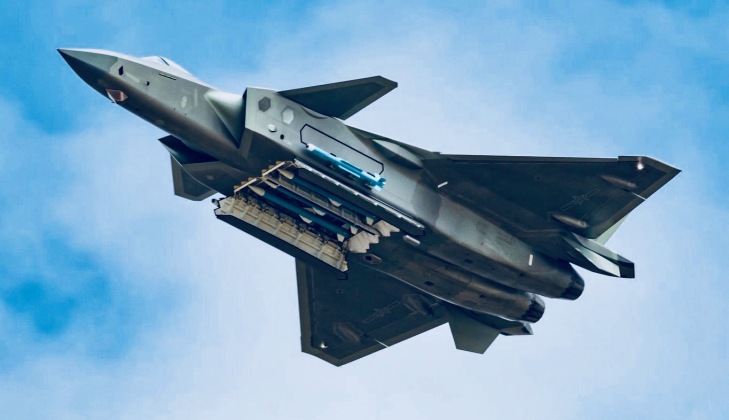On March 14 Commander of the U.S. Pacific Air Forces, Air Force General Kenneth Wilsbach, gave rare insight into prevailing American thought on China’s J-20 fifth generation fighter, commenting on the aircraft as he confirmed the first ever encounter between America’s own sole production fifth generation jet the F-35 and the J-20 over the East China Sea. “We notice that they are flying it pretty well. We recently had – I wouldn’t call it an engagement – where we got relatively close to the J-20s along with our F-35s in the East China Sea, and we’re relatively impressed with the command and control associated with the J-20,” he stated. One major point Wilsbach raised was ongoing uncertainty regarding the future of the J-20 program, namely whether it would remain a specialised dedicated air superiority fighter, or whether it would in future begin to integrate standoff air to ground or anti shipping weapons to become a multirole fighter. He stated to this effect: “It’s a bit early to say what they intend to do with the J-20, so really all we’ve seen it do is air superiority… We’re seeing relatively professional flying and it’s still too early to tell exactly what they intend to do with [the J-20] – whether it’s going to be more like an F-35 that’s capable of doing many, many missions or more like an F-22 that is primarily an air superiority fighter that has an air to ground capability.”

The J-20 has so far been seen armed only with air to air missiles, namely the PL-15 and PL-10 for respective long and short range engagements both of which are considered among the most capable in the world. The fighter is from the same weight range as the American F-22 and Russian Su-57 fifth generation fighters, the former which cannot carry any standoff weapons for roles other than air to air combat and had a basic precision bombing capability added years after entering service, while the latter was designed from the outset to carry high diameter strike and anti ship missiles internally. The much lighter single engine F-35, which is the only fighter other than the J-20 which is both in production and fielded at squadron level strength, is versatile like the Su-57 but has a much lower endurance and smaller capacity for all kinds of weapons. It remains uncertain whether the J-20 will be more like the F-22, or like the F-35 and Su-57. Some indications that it could potentially be a multirole aircraft are that it has been assigned strike missions in simulated exercises including suppression of enemy air defences, potentially indicating that there is a standoff air to ground weapon for it either in service or under development. Another possibility is that different J-20 variants or derivatives of the design will be capable of strike missions where standard variants were not – much as a strike variant of the F-22 was considered under the FB-22 program. A twin seat variant of the J-20 unveiled in October 2021, which remains the world’s only fifth generation twin seat fighter, could potentially form the basis for development of a strike variant with a second seat favourable for such missions.

General Wilsbach further elaborated on the Chinese fleet, and the role of the KJ-500 airborne early waning (AEW) aircraft which accompanied J-20s during their run in with F-35s over the East China Sea: “The KJ-500 plays a significant role in some of their capability for long range fires. Some of their very long range air to air missiles are aided by that KJ-500. Being able to interrupt that kill chain is something that interests me greatly.” While the J-20’s PL-15 has an estimated engagement range of between 200 and 300km, and comfortably outranges anything in the American arsenal, another missile the PL-XX is thought to a range exceeding 500km making it by far the longest ranged air to air missile in the world. Although it has not been seen with the fighter, it could be carried by it externally or by supporting units. 500km would exceed the radar lock on range of any known fighter, requiring support from the KJ-500 or another AEW aircraft. Wilsbach’s statement could indicate that the J-20 is expected to deploy the PL-XX or other very long ranged air to air missiles, and emphasised that the J-20 program remains focused on network centric operations. The J-20 is expected to remain the most capable fighter fielded by a potential U.S. adversary for some years to come, with some analysts considering it the most capable in the world at least until the first sixth generation jets such as the American F-X complete development, and as such assessments of its performance will continue to carry considerable relevance.
